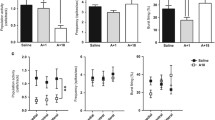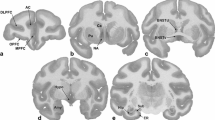Abstract
The hypothesis that separate neural systems mediate the reinforcing properties of opioid and psychomotor stimulant drugs was tested by examining the role of mesolimbic dopamine (DA) neurons in maintaining intravenous heroin and cocaine self-administration. After local destruction of the DA terminals in the nucleus accumbens (NAcc) with 6-hydroxydopamine (6-OHDA), rats trained to self-administer cocaine and heroin on alternate days were observed for changes in their drug-seeking behaviors. Postlesion responding for cocaine showed a time-dependent decrease or extinction, whereas heroin self-administration showed a time-dependent recovery. By the fifth trial postlesion, heroin self-administration had recovered to 76% of prelesion baseline levels, but cocaine self-administration had dropped to 30% of prelesion baseline rates. Thus, selective lesions of the DA terminals in the nucleus accumbens significantly attenuate cocaine but not heroin self-administration. These data support the hypothesis that independent neural subtrates are responsible for the reinforcing actions of these two drugs.
Similar content being viewed by others
References
Bozarth MA, Wise RA (1981a) Heroin reward is dependent on a dopaminergic substrate. Life Sci 29:1881–1886
Bozarth MA, Wise RA (1981b) Intracranial self-administration of morphine into the ventral tegmental area in rats. Life Sci 28:551–555
Davis WM, Smith SG (1975) Effect of haloperidol on (+)-amphetamine self-administration. J Pharm Pharmacol 27:540–542
Deneau GA, Yanagita T, Seevers MH (1969) Self-administration of psychoactive substances by the monkey. Psychopharmacologica 16:30–48
DeWit H, Wise RA (1977) Blockade of cocaine reinforcement in rats with the dopamine receptor blocker pimozide, but not with the noraderenergic blockers phentolamine or phenoxybenzamine. Can J Psychol 31:195–203
DeWit H, Stewart J (1983) Drug reinstatement of heroin-reinforced responding in the rat. Psychopharmacology 79:29–31
Ettenberg A, Pettiit HO, Bloom FE, Koob GF (1982) Heroin and cocaine intravenous self-administration in rats: Mediation by separate neural systems. Psychopharmacology 78:204–209
Felice IJ, Felice JD, Kissinger PT (1978) Determination of catecholamine in rat brain parts by reverse-phase ion pair liquid chromatography. J Neurochem 31:1461–1465
Fibiger HC, Carter DA, Phillips AG (1976) Decreased intracranial self-stimulation after neuroleptics or 6-hydroxydopamine: Evidence for mediation by motor deficits rather than by reduced reward. Psychopharmacology 47:21–27
Goldberg SR, Woods JH, Schuster CR (1971) Nalorphine-induced changes in morphine self-administration in rhesus monkeys. J Pharmacol Exp Ther 176:464–471
Jonsson LE, Anggard E, Gunne LM (1971) Blockade of intravenous amphetamine euphoria in man. Clin Pharmacol Ther 12:889–896
Joyce EM, Koob GF, Strecker R, Iversen SD, Bloom FE (1981) The behavioural effects of enkephalin analogues injected into the ventral tegmental area and globus pallidus. Brain Res 221:359–370
Konig JFR, Klippel RA (1970) The rat brain, a stereotaxic atlas of the forebrain and lower parts of the brain stem. Krieger Publishing, Huntington, NY
Lyness WH, Friedle NM, Moore KE (1979) Destruction of dopaminergic nerve terminals in nucleus accumbens: Effect on d-amphetamine self-administration. Pharmacol Biochem Behav 11:663–556
Phillips AG, LePaine FG (1980) Reinforcing effects of morphine microinjection into the ventral tegmental area. Pharmacol Biochem Behav 12:965–968
Pickens R, Meisch R, Dougherty JA (1968) Chemical interactions in methamphetamine reinforcement. Psychol Rep 23:1267–1270
Pickens R, Harris WC (1968) Self-administration of d-amphetamine by rats. Psycopharmacologia 12:158–163
Pickens R, Meisch RA, Thompson T (1978) Drug self-administration: an analysis of the reinforcing effects of drugs. In: Iversen LL, Iversen SD, Snyder SH (eds) Handbook of psychopharmacology, vol 12. Plenum Press, New York, pp 1–37
Roberts DCS, Corcoran ME, Fibiger HC (1977) On the role of ascending catecholaminergic systems in intravenous self-administration of cocaine. Pharmacol Biochem Behav 6:615–620
Roberts DCS, Koob GF, Klonoff P, Fibiger HC (1980) Extinction and recovery of cocaine self-administration following 6-hydroxydopamine lesions of the nucleus accumbens. Pharmacol Biochem Behav 12:781–787
Robbins TW, Roberts DCS, Koob GF (1983) The effects of d-amphetamine and apomorphine upon operant behavior and schedule-induce licking in rats with 6-hydroxydopamine-induced lesions of the nucleus accumbens. J Pharmacol Exp Ther 224:662–673
Schuster CR, Thompson T (1969) Self-administration of and behavioral dependence on drugs. Ann Rev Pharmacol 9:483–502
Schwartz AS, Marchol PL (1974) Depression of morphine-seeking behavior by dopamine inhibition. Nature 248:257–258
Spyraki C, Fibiger HC, Phillips AG (1982) Cocaine-induced place preference conditioning: lack of effects of neuroleptics and 6-hydroxydopamine lesions. Brain Res 253:195–203
Spyraki C, Fibiger HC, Phillips AG (1983) Attenuation of heroin reward in rats by disruption of the mesolimbic dopamine system. Psychopharmacology 79:278–283
Thompson T, Pickens R (1970) Stimulant self-administration by animals: some comparisons with opiate self-administration. Fed Proc 29:6–11
Weeks JR (1972) Long term intravenous infusion. In: Myers RD (ed) Methods in psychobiology, (vol 2), Academic Press London, pp 155–168
Weeks JR, Collins RJ (1976) Changes in morphine self-administration in rats induced by prostaglandin E and naloxone. Prostaglandins 12:11–19
Werner TE, Smith SG, Davis WM (1976) A dose-response comparison between methadone and morphine self-administration. Psychopharmacologia 47:209–211
Wise RA (1980) The dopamine synapse and the notion of “pleasure centers in the brain”. Trends Neurosci 3:91–94
Woods JH, Schuster CR (1968) Reinforcement properties of morphine, cocaine, and SPA as a function of unit dose. Int J Addict 3:231–237
Yokel RA, Pickens R (1973) Self-administration of optical isomers of amphetamine and methylamphetamine by rats. J Pharmacol Exp Ther 1887:27–33
Yokel RA, Wise RA (1975) Increased lever pressing for amphetamine after pimozide in rats: implications for a dopamine theory of reward. Science 187:547–549
Yokel RA, Wise RA (1976) Attenuation of intravenous amphetamine reinforcement by central dopamine blockade in rats. Psychopharmacology 48:311–318
Author information
Authors and Affiliations
Rights and permissions
About this article
Cite this article
Pettit, H.O., Ettenberg, A., Bloom, F.E. et al. Destruction of dopamine in the nucleus accumbens selectively attenuates cocaine but not heroin self-administration in rats. Psychopharmacology 84, 167–173 (1984). https://doi.org/10.1007/BF00427441
Received:
Accepted:
Issue Date:
DOI: https://doi.org/10.1007/BF00427441




